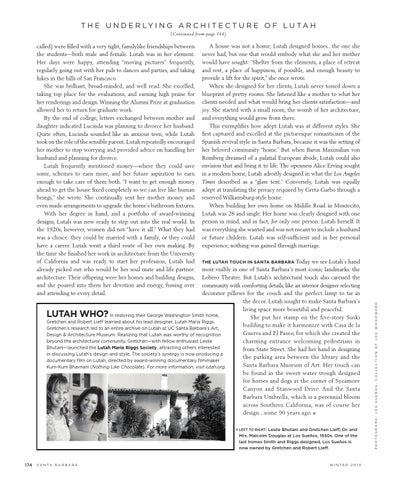T H E U N D E R LY I N G A R C H I T E C T U R E O F L U TA H (Continued from page 144)
A house was not a home; Lutah designed homes...the one she never had, but one that would embody what she and her mother would have sought: “Shelter from the elements, a place of retreat and rest, a place of happiness, if possible, and enough beauty to provide a lift for the spirit,” she once wrote. When she designed for her clients, Lutah never tossed down a blueprint of pretty rooms. She listened like a mother to what her clients needed and what would bring her clients satisfaction—and joy. She started with a small room, the womb of her architecture, and everything would grow from there. This exemplifies how adept Lutah was at different styles. She first captured and excelled at the picturesque romanticism of the Spanish revival style in Santa Barbara, because it was the setting of her beloved community “home.” But when Baron Maximilian von Romberg dreamed of a palatial European abode, Lutah could also envision that and bring it to life. The openness Alice Erving sought in a modern home, Lutah adroitly designed in what the Los Angeles Times described as a “glass tent.” Conversely, Lutah was equally adept at translating the privacy required by Greta Garbo through a reserved Williamsburg-style home. When building her own home on Middle Road in Montecito, Lutah was 28 and single. Her home was clearly designed with one person in mind, and in fact, for only one person: Lutah herself. It was everything she wanted and was not meant to include a husband or future children. Lutah was self-sufficient and in her personal experience, nothing was gained through marriage.
THE LUTAH TOUCH IN SANTA BARBARA Today we see Lutah’s hand most visibly in one of Santa Barbara’s most iconic landmarks: the Lobero Theatre. But Lutah’s architectural touch also caressed the community with comforting details, like an interior designer selecting decorator pillows for the couch and the perfect lamp to tie in the decor. Lutah sought to make Santa Barbara’s living space more beautiful and peaceful. In restoring their George Washington Smith home, She put her stamp on the five-story Suski Gretchen and Robert Lieff learned about his lead designer, Lutah Maria Riggs. building to make it harmonize with Casa de la Gretchen’s research led to an entire archive on Lutah at UC Santa Barbara’s Art, Guerra and El Paseo, for which she created the Design & Architecture Museum. Realizing that Lutah was worthy of recognition beyond the architectural community, Gretchen—with fellow enthusiast Leslie charming entrance welcoming pedestrians in Bhutani—launched the Lutah Maria Riggs Society, attracting others interested from State Street. She had her hand in designing in discussing Lutah’s design and style. The society’s synergy is now producing a the parking area between the library and the documentary film on Lutah, directed by award-winning documentary filmmaker Santa Barbara Museum of Art. Her touch can Kum-Kum Bhavnani (Nothing Like Chocolate). For more information, visit lutah.org. be found in the sweet water trough designed for horses and dogs at the corner of Sycamore Canyon and Stanwood Drive. And the Santa Barbara Umbrella, which is a perennial bloom across Southern California, was of course her design...some 90 years ago. n
LUTAH WHO?
< LEFT TO RIGHT: Leslie Bhutani and Gretchen Lieff; Dr. and Mrs. Malcolm Douglas at Los Sueños, 1930s. One of the last homes Smith and Riggs designed, Los Sueños is now owned by Gretchen and Robert Lieff.
174
S A N TA B A R B A R A
winter14.lutahriggs.indd 174
P H OTO G R A P H : LO S S U E N O S , C O L L E C T I O N O F J O E WO O DWA R D
called) were filled with a very tight, familylike friendships between the students—both male and female. Lutah was in her element. Her days were happy, attending “moving pictures” frequently, regularly going out with her pals to dances and parties, and taking hikes in the hills of San Francisco. She was brilliant, broad-minded, and well read. She excelled, taking top place for the evaluations, and earning high praise for her renderings and design. Winning the Alumni Prize at graduation allowed her to return for graduate work. By the end of college, letters exchanged between mother and daughter indicated Lucinda was planning to divorce her husband. Quite often, Lucinda sounded like an anxious teen, while Lutah took on the role of the sensible parent. Lutah repeatedly encouraged her mother to stop worrying and provided advice on handling her husband and planning for divorce. Lutah frequently mentioned money—where they could save some, schemes to earn more, and her future aspiration to earn enough to take care of them both. “I want to get enough money ahead to get the house fixed completely so we can live like human beings,” she wrote. She continually sent her mother money and even made arrangements to upgrade the home’s bathroom fixtures. With her degree in hand, and a portfolio of award-winning designs, Lutah was now ready to step out into the real world. In the 1920s, however, women did not “have it all.” What they had was a choice: they could be married with a family, or they could have a career. Lutah went a third route of her own making. By the time she finished her work in architecture from the University of California and was ready to start her profession, Lutah had already picked out who would be her soul mate and life partner: architecture. Their offspring were her homes and building designs, and she poured into them her devotion and energy, fussing over and attending to every detail.
WINTER 2014
11/13/13 3:39 PM
